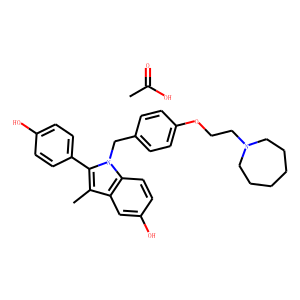| Reference | 1. Drugs. 2011 Nov 12;71(16):2193-212. doi: 10.2165/11207420-000000000-00000.
<br>
Bazedoxifene: a review of its use in the treatment of postmenopausal
osteoporosis.
<br>
Duggan ST(1), McKeage K.
<br>
Author information: <br>
(1)Adis, a Wolters Kluwer Business, Auckland, New Zealand.
<br>
Bazedoxifene (Conbriza®, Viviant®) is the first third-generation selective
estrogen receptor modulator (SERM) and it is approved for the treatment of
postmenopausal osteoporosis in the EU and Japan. Bazedoxifene contains an
indole-based core binding domain that binds with high affinity to estrogen
receptors and exhibits favourable effects on bone and lipid profiles, with no
clinically relevant endometrial or breast stimulation. Oral bazedoxifene once
daily reduced the incidence of new vertebral fractures in patients with
postmenopausal osteoporosis in a large, well designed trial of 3 years/’ duration;
both bazedoxifene and raloxifene were significantly more effective than placebo.
Neither bazedoxifene nor raloxifene reduced the incidence of nonvertebral
fractures in the overall study population; however, bazedoxifene, but not
raloxifene, reduced the rate of nonvertebral fractures in high-risk patients.
Moreover, data from patients who continued to receive the drug during a 2-year
extension phase of this trial indicate that bazedoxifene continues to provide
protection against new vertebral fractures for up to 5 years. Bazedoxifene also
increases bone mineral density and reduces the levels of bone turnover markers.
Bazedoxifene was generally well tolerated and did not detrimentally affect the
reproductive tract or breast tissue in clinical trials, thereby demonstrating a
favourable risk-benefit profile. A pharmacoeconomic analysis conducted from an EU
perspective predicted bazedoxifene to be cost effective in some EU countries.
Therefore, bazedoxifene presents another useful option for the treatment of
postmenopausal osteoporosis, especially in those at high risk for osteoporotic
fracture.
<br>
2. Clin Interv Aging. 2011;6:151-60. doi: 10.2147/CIA.S15711. Epub 2011 Jun 21.
<br>
Efficacy and safety of bazedoxifene for postmenopausal osteoporosis.
<br>
Kawate H(1), Takayanagi R.
<br>
Author information: <br>
(1)Department of Medicine and Bioregulatory Science, Graduate School of Medical
Sciences, Kyushu University, Fukuoka, Japan.
<br>
Bazedoxifene, a novel selective estrogen receptor modulator, has been developed
to have favorable effects on bone and the lipid profile while minimizing
stimulation of uterine or breast tissues. Two large Phase III clinical trials
showed that bazedoxifene, as well as raloxifene, increased bone mineral density,
decreased levels of bone turnover markers, and significantly reduced the risk of
new vertebral fractures in postmenopausal women compared with placebo. Although
the incidence of nonvertebral fractures with bazedoxifene or raloxifene did not
differ significantly from that with placebo, a post hoc analysis of a subgroup of
women at higher fracture risk revealed that bazedoxifene significantly reduced
the nonvertebral fracture risk relative to placebo and raloxifene. Bazedoxifene
also improved the lipid profile by reducing the serum concentrations of total
cholesterol and low-density lipoprotein cholesterol, with an increase in the
serum level of high-density lipoprotein cholesterol. The incidences of
vasodilatation (hot flushes), leg cramps, and venous thromboembolic events were
significantly higher with bazedoxifene and raloxifene compared with placebo.
There was no evidence of endometrial and breast stimulation with bazedoxifene.
Taking advantage of the favorable effects of bazedoxifene on the breast and
endometrium, the pairing of bazedoxifene with conjugated estrogens is under
investigation for the treatment of menopausal symptoms and prevention of
postmenopausal osteoporosis. A Phase III trial showed that combination therapy of
bazedoxifene and conjugated estrogens significantly increased bone mineral
density and decreased bone turnover markers, with relief of hot flushes and
improvement of vaginal atrophy. This article reviews the clinical efficacy and
safety of bazedoxifene in the treatment of postmenopausal osteoporosis.
<br>
3. Drugs Today (Barc). 2009 Jul;45(7):507-20. doi: 10.1358/dot.2009.45.7.1395293.
<br>
Bazedoxifene acetate: a novel selective estrogen receptor modulator for the
prevention and treatment of postmenopausal osteoporosis.
<br>
Chines AA(1), Komm BS.
<br>
Author information: <br>
(1)Wyeth Research, Collegeville, Pennsylvania, USA.
<br>
Postmenopausal osteoporosis is an increasing worldwide health concern affecting
an estimated 200 million individuals. Despite a wide range of available treatment
options, many patients are not being treated or discontinue therapy. The ongoing
need for new osteoporosis therapies has led to the development of new selective
estrogen receptor modulators (SERMs) with an ideal tissue selectivity profile and
beneficial effects on bone without undesirable effects on the endometrium and
breast. Bazedoxifene acetate, a novel SERM in clinical development for the
prevention and treatment of postmenopausal osteoporosis, resembles this ideal
profile more closely than other currently available SERMs. Results from large
prospective phase III trials showed that it increases bone mineral density,
reduces bone turnover rate and decreases the risk for new vertebral fractures.
Moreover, based on a post hoc analysis of a subgroup of women with a higher risk
for fracture, bazedoxifene was demonstrated to significantly reduce the incidence
of nonvertebral fractures compared with both raloxifene hydrochloride and
placebo. Furthermore, it was reported to be well tolerated, with a favorable
safety profile and no evidence of endometrial or breast tissue stimulation.
Bazedoxifene represents an important new treatment option for women at risk for
osteoporosis and fracture.
<br>
|

